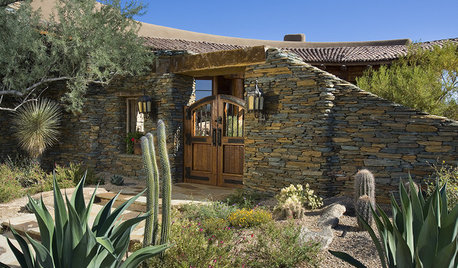Alkaline soil resultin in Iron deficiency, solution?
ju1234
9 years ago
Related Stories

GARDENING GUIDESGrow a Beautiful Garden in Alkaline Soil
Got alkaline soil? Learn how to manage it and the many beautiful plants that will thrive in this ‘sweet’ soil
Full Story
GARDENING GUIDESGarden Myths to Debunk as You Dig This Fall and Rest Over Winter
Termites hate wood mulch, don’t amend soil for trees, avoid gravel in planters — and more nuggets of garden wisdom
Full Story
FARM YOUR YARDHow to Farm Your Parking Strip
Get an up-close look at a thriving street-side edible garden, one of many sprouting up in Seattle
Full Story
LANDSCAPE DESIGNLay of the Landscape: Southwestern Garden Style
Water may be scarce, but color and striking foliage are as profuse in the desert landscape as the sunsets are breathtaking
Full Story
GARDENING GUIDESWhat's Wrong With My Plant? Leaves Often Hold the Clues
Learn how to identify common plant ailments by reading their leaves
Full Story
FARM YOUR YARDHow to Grow Vegetables in Containers
Get glorious vegetables and fruits on your patio with a pro’s guidance — including his personal recipe for potting mix
Full Story
GARDENING GUIDES5 Great Grasses for a New Lawn
Learn about maintenance, wear tolerance, ideal climate and more for these top turf choices to pick the right one for you
Full Story
HOUSEKEEPINGDon't Touch Another Stain Before You Read This
Even an innocent swipe with water may cause permanent damage. Here's what to know about how rugs and fabrics react
Full Story
GARDENING GUIDESHow to Keep Your Citrus Trees Well Fed and Healthy
Ripe for some citrus fertilizer know-how? This mini guide will help your lemon, orange and grapefruit trees flourish
Full Story
GARDENING GUIDESHow to Switch to an Organic Landscape Plan
Ditch the chemicals for a naturally beautiful lawn and garden, using living fertilizers and other nontoxic treatments
Full StoryMore Discussions







bostedo: 8a tx-bp-dfw
allen_gw
Related Professionals
Eden Prairie Landscape Architects & Landscape Designers · Erie Landscape Architects & Landscape Designers · Paradise Landscape Architects & Landscape Designers · Brookline Landscape Contractors · Broomfield Landscape Contractors · Gainesville Landscape Contractors · Gurnee Landscape Contractors · Metairie Landscape Contractors · North Richland Hills Landscape Contractors · South Lyon Landscape Contractors · Vashon Landscape Contractors · Waipahu Landscape Contractors · Cutler Ridge Window Contractors · Framingham Window Contractors · Orlando Window Contractorsju1234Original Author
TXSkeeter
bostedo: 8a tx-bp-dfw
rcnaylor
lazy_gardens
Mackel-in-DFW